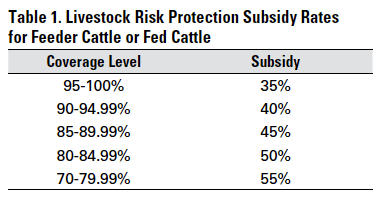Elevate Your Experience with Bagley Risk Management
Wiki Article
Understanding Livestock Danger Security (LRP) Insurance: A Comprehensive Overview
Browsing the world of animals threat protection (LRP) insurance coverage can be an intricate endeavor for numerous in the farming market. This kind of insurance coverage provides a security web versus market fluctuations and unexpected conditions that could impact livestock producers. By recognizing the intricacies of LRP insurance, manufacturers can make enlightened choices that may guard their operations from monetary risks. From just how LRP insurance coverage operates to the numerous insurance coverage choices available, there is much to reveal in this comprehensive overview that could possibly shape the means animals manufacturers come close to threat administration in their services.

How LRP Insurance Coverage Works
Sometimes, comprehending the auto mechanics of Livestock Risk Protection (LRP) insurance can be complicated, however breaking down exactly how it functions can give clearness for farmers and ranchers. LRP insurance policy is a risk monitoring device designed to safeguard animals manufacturers against unforeseen rate declines. It's vital to keep in mind that LRP insurance policy is not an earnings guarantee; rather, it focuses entirely on rate threat protection.Qualification and Protection Options

When it involves coverage options, LRP insurance coverage supplies producers the versatility to select the coverage degree, coverage period, and endorsements that ideal fit their danger administration requirements. Coverage levels generally vary from 70% to 100% of the anticipated ending worth of the insured animals. Producers can also choose protection durations that straighten with their manufacturing cycle, whether they are guaranteeing feeder livestock, fed livestock, swine, or lamb. Recommendations such as price risk defense can further tailor coverage to shield versus unfavorable market changes. By understanding the qualification criteria and protection alternatives offered, livestock producers can make enlightened decisions to manage threat effectively.
Advantages And Disadvantages of LRP Insurance
When assessing Livestock Risk Protection (LRP) insurance coverage, it is important for animals manufacturers to weigh the advantages and drawbacks fundamental in this threat administration device.
Among the key advantages of LRP insurance coverage is its capacity to provide protection against a decrease in animals rates. This can aid guard manufacturers from monetary losses resulting from market fluctuations. Furthermore, LRP insurance supplies a level of flexibility, allowing manufacturers to tailor insurance coverage degrees and plan periods to match their certain requirements. By securing in a guaranteed cost for their animals, producers can much better manage risk and strategy for the future.
Nevertheless, there are likewise some downsides to consider. One limitation of LRP insurance coverage is that it does not safeguard against all kinds of dangers, such as disease outbreaks or all-natural disasters. Furthermore, premiums can often be expensive, particularly for manufacturers with large animals herds. It is essential for manufacturers to thoroughly evaluate their private danger direct exposure and monetary situation to identify if LRP insurance policy is the appropriate danger monitoring tool for their procedure.
Recognizing LRP Insurance Policy Premiums

Tips for Making Best Use Of LRP Conveniences
Optimizing the advantages of Livestock Threat Protection (LRP) insurance policy requires critical preparation and positive threat monitoring - Bagley Risk Management. To make the many of your LRP coverage, take into consideration the complying with suggestions:Regularly Examine Market Problems: Keep educated about market patterns and cost variations in the animals market. By checking these aspects, you can make enlightened decisions about when to acquire LRP coverage to safeguard against possible losses.
Set Realistic Insurance Coverage Degrees: When selecting insurance coverage levels, consider your manufacturing prices, market worth of livestock, and prospective dangers - Bagley Risk Management. Setting realistic protection levels makes blog sure that you are adequately protected without overpaying for unnecessary insurance
Diversify Your Coverage: Instead of counting only on LRP insurance coverage, consider diversifying your danger management techniques. Integrating LRP with other threat administration tools such as futures contracts or alternatives can offer thorough coverage against market uncertainties.
Review and Change Protection Routinely: As market problems alter, occasionally evaluate your LRP protection to guarantee it aligns with your current risk direct exposure. Readjusting insurance coverage levels and timing of purchases can help enhance your threat defense approach. By following these suggestions, you can optimize the advantages of LRP insurance and guard your animals operation against unpredicted dangers.
Verdict
To conclude, livestock risk security (LRP) insurance coverage is a useful device for farmers to handle the economic threats linked with their livestock operations. By understanding how LRP functions, eligibility and insurance coverage choices, as well as the advantages and disadvantages of this insurance coverage, farmers can make enlightened decisions to secure their resources. By carefully considering LRP costs and executing approaches to maximize advantages, farmers can reduce prospective losses and ensure the sustainability of their operations.
Animals producers interested in acquiring Animals Risk Security (LRP) insurance policy can discover an array of qualification standards and insurance coverage alternatives customized to their particular livestock operations.When it comes to coverage options, LRP insurance policy supplies producers the flexibility to select the insurance coverage level, insurance coverage duration, and recommendations that finest fit their threat administration demands.To realize the complexities of Animals Threat Protection (LRP) insurance totally, recognizing the variables influencing LRP insurance premiums is vital. LRP insurance policy premiums are figured out by various elements, consisting of the protection degree chosen, the anticipated price of livestock at the end of the insurance coverage period, the type of animals being insured, and the length of the coverage duration.Review and Readjust Coverage On a regular basis: As market conditions transform, periodically assess your my website LRP coverage to guarantee it aligns with your current risk exposure.
Report this wiki page